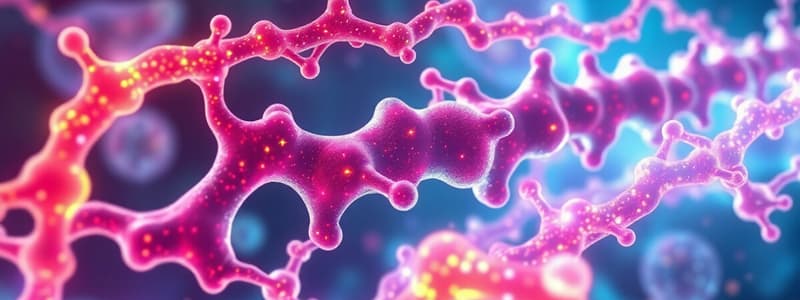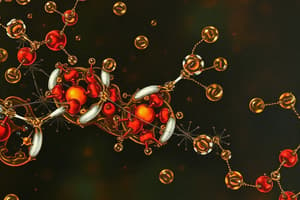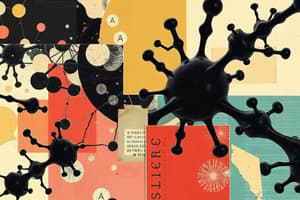Podcast
Questions and Answers
How do enzymes accelerate biochemical reactions?
How do enzymes accelerate biochemical reactions?
- By increasing the temperature of the reaction environment.
- By decreasing the activation energy required for the reaction. (correct)
- By being consumed during the reaction.
- By increasing the activation energy required for the reaction.
In the 'lock and key' model of enzyme function, what is the significance of the enzyme's shape?
In the 'lock and key' model of enzyme function, what is the significance of the enzyme's shape?
- It ensures the enzyme can bind to any substrate in the cell.
- It determines the enzyme's color and visual properties.
- It allows the enzyme to regulate the temperature of the reaction.
- It ensures the enzyme binds only to a specific substrate. (correct)
Which type of enzyme is responsible for catalyzing oxidation-reduction reactions?
Which type of enzyme is responsible for catalyzing oxidation-reduction reactions?
- Isomerase
- Kinase
- Synthase
- Oxidoreductase (correct)
Hexokinase catalyzes the reaction: Glucose + ATP → Glucose-6-Phosphate + ADP. What type of enzyme is hexokinase?
Hexokinase catalyzes the reaction: Glucose + ATP → Glucose-6-Phosphate + ADP. What type of enzyme is hexokinase?
An enzyme is known to catalyze a reaction that involves the rearrangement of a molecule's structural configuration. Which class does this enzyme belong to?
An enzyme is known to catalyze a reaction that involves the rearrangement of a molecule's structural configuration. Which class does this enzyme belong to?
Which statement accurately describes the relationship between glucose and fructose?
Which statement accurately describes the relationship between glucose and fructose?
In a dehydrogenase reaction, if a molecule of substrate 'A' loses hydrogen atoms, which of the following statements is correct according to the principles of oxidation and reduction?
In a dehydrogenase reaction, if a molecule of substrate 'A' loses hydrogen atoms, which of the following statements is correct according to the principles of oxidation and reduction?
During high-intensity exercise, lactate dehydrogenase (LDH) catalyzes the conversion of pyruvate to lactate. Which of the following is also produced in this reaction?
During high-intensity exercise, lactate dehydrogenase (LDH) catalyzes the conversion of pyruvate to lactate. Which of the following is also produced in this reaction?
Which of the following best describes the role of synthase enzymes?
Which of the following best describes the role of synthase enzymes?
Which of the following vitamins functions as a coenzyme?
Which of the following vitamins functions as a coenzyme?
During high-intensity exercise, the activity of a rate-limiting enzyme in glycolysis increases. How does this adaptation primarily benefit the muscle cells?
During high-intensity exercise, the activity of a rate-limiting enzyme in glycolysis increases. How does this adaptation primarily benefit the muscle cells?
Considering the mass action effect, if a muscle cell has an abundance of glucose, which of the following is most likely to occur?
Considering the mass action effect, if a muscle cell has an abundance of glucose, which of the following is most likely to occur?
Lactate dehydrogenase (LDH) plays a crucial role during intense exercise. What is the primary function of LDH in muscle cells under anaerobic conditions?
Lactate dehydrogenase (LDH) plays a crucial role during intense exercise. What is the primary function of LDH in muscle cells under anaerobic conditions?
ATP synthase is a critical enzyme in the electron transport chain. How does ATP synthase contribute to energy production within the mitochondria?
ATP synthase is a critical enzyme in the electron transport chain. How does ATP synthase contribute to energy production within the mitochondria?
Glucose and fructose are isomers. If an isomerase enzyme acts upon glucose, what is the most likely outcome?
Glucose and fructose are isomers. If an isomerase enzyme acts upon glucose, what is the most likely outcome?
During hydrolysis, what role does water play in the breakdown of macronutrients?
During hydrolysis, what role does water play in the breakdown of macronutrients?
In a condensation reaction, what is the role of water?
In a condensation reaction, what is the role of water?
Which statement accurately describes the process of oxidation?
Which statement accurately describes the process of oxidation?
In a redox reaction, if a molecule is reduced, what happens to its electron count and charge?
In a redox reaction, if a molecule is reduced, what happens to its electron count and charge?
During recovery from exercise, lactate is converted to pyruvate via the lactate dehydrogenase (LDH) reaction. Considering this is a redox reaction, what specifically happens to lactate?
During recovery from exercise, lactate is converted to pyruvate via the lactate dehydrogenase (LDH) reaction. Considering this is a redox reaction, what specifically happens to lactate?
In the lactate dehydrogenase (LDH) reaction during recovery from exercise, what is the fate of $NAD^+$?
In the lactate dehydrogenase (LDH) reaction during recovery from exercise, what is the fate of $NAD^+$?
Approximately what percentage of ATP production is attributed to redox reactions within the electron transport chain?
Approximately what percentage of ATP production is attributed to redox reactions within the electron transport chain?
What role does oxygen play in the final stage of the electron transport chain?
What role does oxygen play in the final stage of the electron transport chain?
Flashcards
Enzymes
Enzymes
Proteins that speed up reactions without being changed themselves; lowers activation energy.
Lock & Key Model
Lock & Key Model
Enzymes bind only to specific substrates based on shape.
-ase
-ase
Enzyme names typically end with this suffix.
Kinase or Phosphorylase
Kinase or Phosphorylase
Signup and view all the flashcards
Oxidoreductases
Oxidoreductases
Signup and view all the flashcards
Glucose-6-phosphate (G6P)
Glucose-6-phosphate (G6P)
Signup and view all the flashcards
Dehydrogenase
Dehydrogenase
Signup and view all the flashcards
ATP synthase
ATP synthase
Signup and view all the flashcards
Mass action effect
Mass action effect
Signup and view all the flashcards
Isomers
Isomers
Signup and view all the flashcards
Synthase enzymes
Synthase enzymes
Signup and view all the flashcards
Hydrolysis enzymes
Hydrolysis enzymes
Signup and view all the flashcards
OIL RIG
OIL RIG
Signup and view all the flashcards
Hydrolysis
Hydrolysis
Signup and view all the flashcards
Condensation
Condensation
Signup and view all the flashcards
Oxidation
Oxidation
Signup and view all the flashcards
Reduction
Reduction
Signup and view all the flashcards
LDH Redox Reaction
LDH Redox Reaction
Signup and view all the flashcards
Electron Transport
Electron Transport
Signup and view all the flashcards
Rate-Limiting Enzyme
Rate-Limiting Enzyme
Signup and view all the flashcards
Enzyme Names
Enzyme Names
Signup and view all the flashcards
Study Notes
- Enzymes are specialized proteins that catalyze reactions without being changed themselves.
- Enzymes lower the activation energy required for chemical reactions
- Enzymes facilitate the breakdown of substrates or the building of new ones.
- They control metabolic pathways and influence hormone effects.
Lock & Key Model
- Enzyme-substrate interactions ensure that the correct enzyme binds to its specific substrate.
- Matching ensures a particular function is performed
- Only the required substrates fit into a specific enzyme.
- Changes to an enzyme's shape affect its function.
Enzyme Terminology
- Most enzyme names end in "-ase".
- Kinases or phosphorylases catalyze the transfer of a phosphate group.
- Oxidoreductases, such as dehydrogenase or oxidase, catalyze redox reactions by transferring hydrogen atoms.
- Isomerases rearrange molecular structures.
- Synthases synthesize molecules.
Kinase Example
- Hexokinase removes a phosphate group from ATP and adds it to glucose.
- This is the first step of glycolysis and traps glucose in a muscle cell.
Dehydrogenase Example
- Lactate dehydrogenase removes two hydrogens (and electrons) from lactate and adds them to NAD⁺.
Isomerase Example
- Glucose and fructose are isomers, meaning they have the same chemical formula (C₆H₁₂O₆).
- Glucose has a hexagon shape while fructose has a pentagon shape.
- Glucose isomerase changes the shape of glucose without changing the formula.
Synthase Example
- ATP synthase synthesizes ATP by adding a phosphate (PO₃⁻) to ADP.
- This process occurs in the mitochondria during the final step of the electron transport chain (ETC).
- Over 90% of ATP is produced through this reaction.
Coenzymes
- Coenzymes are nonprotein organic substances.
- They facilitate enzyme action by binding a substrate to a specific enzyme, examples include NAD and FAD.
- Coenzymes are often changed by the reaction.
Mass Action Effect
- The mass action effect describes how substrate availability affects metabolic rate.
- The more substrate available, the higher the pathway activity.
- An excess of a given substrate causes cells to rely more on that energy substrate than others.
Rate-Limiting Enzymes
- A rate-limiting enzyme controls the speed of a metabolic process.
- Exercise intensity and speed reflect the body's capacity to transfer chemical energy into mechanical work
- Factors such as temperature, pH, and other chemicals can alter enzyme activity.
Hydrolysis
- Hydrolysis involves splitting chemical bonds through the addition of H⁺ and OH⁻ to reaction byproducts
- Hydrolysis catabolizes macronutrients into simpler forms for easier absorption and assimilation.
- Hydrolysis requires H₂O.
- Examples of hydrolysis enzymes include ATPase, lactase, and sucrase
Condensation
- Condensation involves the binding of structural components.
- Nutrients form more complex molecules and compounds.
- Condensation "releases" H₂O.
Redox Reactions
- Oxidation is a reaction that transfers (loses) electrons or hydrogen atoms.
- Reduction is any process in which atoms in an element gain electrons (or H⁺).
- The lactate dehydrogenase (LDH) reaction in recovery.
- Lactate is oxidized (loses 2 H⁺) to become pyruvate.
- NAD⁺ gains one H (and two electrons) and is reduced to become NADH, while an extra H⁺ is nearby.
Respiratory Chain and Electron Transport
- The vast majority (~90%) of our ATP is produced from redox reactions.
- Electron transport represents the final common pathway in aerobic metabolism.
- For each pair of hydrogen atoms, two electrons flow down the chain and reduce one oxygen atom.
- The process ends when oxygen accepts two hydrogens and forms water.
Studying That Suits You
Use AI to generate personalized quizzes and flashcards to suit your learning preferences.



